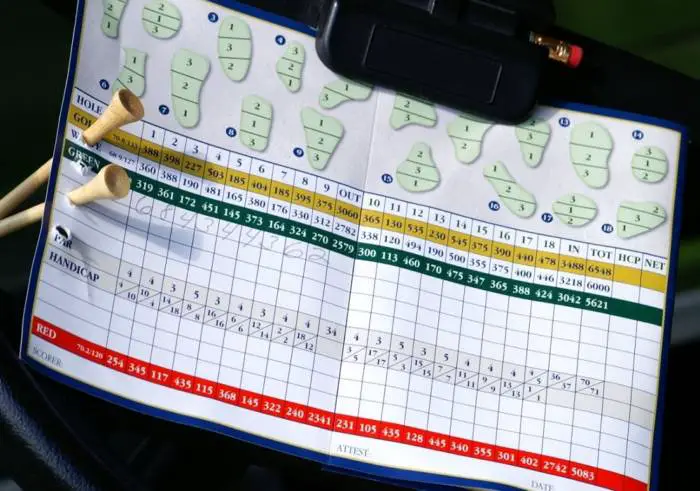How To Read A Golf Scorecard
If you’ve recently taken up a new hobby or activity you will know the struggle of not fully understanding how to do something. This is completely normal when you first start something new, but it doesn’t make it less frustrating.
Golf is no different. Although it’s a relatively simple concept and game to play, it can be difficult to understand the rules and how to keep score.

Especially when it comes to reading a scorecard, it can feel like you’re looking at a completely foreign language to you. Luckily, in this article, we’re going to explain exactly how to read a golf scorecard.
Hole number
A standard golf course should have either 9 or 18 holes. There may be some shorter golf courses that have 6 holes or some courses in-between that have 12 or even courses that have 27. But generally, a round of golf is played over 18 holes – a front 9 and back 9.
Regardless of the amount of holes on the golf course, they should be played in consecutive order, starting at 1 to however many holes there are on the course.
Tee Colour
The first thing you need to do is determine which tee you’re playing from as each golf course will have a number of different tees on each hole.
Traditionally these rangeTraditionally these ranged by gender; yellow for mens, white for mens competitions and red for womens. However many golf courses these days are adapting a more flexible approach and are instead encouraging golfers to play from the appropriate tee for their level. If you’re not sure what that is – it’s worth asking in the pro shop before teeing off.
As a general guide, the colours are ordered as below (but this can change per course)
- Red – Easiest tees designed for beginners or high handicappers
- Yellow – Medium tees for the average golfer
- White – Harder tees for competitions or lower handicappers
- Blue – Championship tees, generally the hardest on the course and designed for scratch golfers
- Blacks – Tiger tees – you’ve got to be good to play from these!
Yardage
On a scorecard underneath hole number, you will see the number of yards for each hole from the tee box to the green. There will be varying differences between each tee box depending on the course and hole.
Also, the actual distance of the hole when you’re playing may differ as clubs tend to move the tee boxes around to protect them from overuse. Be sure to check if you’re playing from the standard tees before teeing off.
The yardage doesn’t always indicate the difficulty of the hole. The example card below, hole number 3, a 190 yard par 3 from the white tees is arguably more difficult than the 4th hole, a 480 yard par 5.

This brings us nicely onto the next point, the par.
Par
The par on a scorecard indicates the number of shots that it should take to get the ball into the hole. Each hole will have its own par, ranging from 3 to 5.
If for example you are on a par 3 you should aim to get into the hole in 3 or less shots. If you go one shot over the par, you score what is called a bogey. You finish two over par, you score a double bogey, and so on.
If you add the 18 pars for each hole, you’ll have a par for the course, which is the expected number of shots you should take for the whole round. A normal golf course will have an overall par between 69-72, depending on the amount of par 3 and par 5 holes they have.
Handicap / Stroke Index
Scoring a par isn’t easy. Especially when starting out, you’re going to struggle to make many pars.
So to even the game out, golfers play with a handicap. Handicap is also related to the ability of the golfer and is usually the number of strokes on average they finish over par on a round (the lower the better), which then get taken off your final gross score.
Every hole you play on any golf course will also have a handicap or stroke index. The handicap or stroke index is essentially a rating system to work out what the hardest hole is on a specific golf course. A handicap of 1 being the hardest and a handicap of 18 would make it the easiest of the holes.
Depending on your handicap, you’ll receive shots on different holes on the course when playing certain formats of the game (such as stableford). For instance, if you play off 9, you receive a shot on each of the holes with a stroke index of 1-9.
Slope and Course Rating
The course rating or course slope is what defines how difficult a course actually is.
Just because a golf course is short, with a par of 70 doesn’t necessarily mean that it’s an easy course. There are other factors that play a part in what makes a golf course difficult such as; the type of terrain, the width of the fairways, the length of the rough, the number of bunkers, water hazards and undulation on the greens.
The course slope is designed to modify a golfer’s handicap to make up for the difficulty of the golf course they are teeing it up on, taking into account which tee colour you’re playing from.
In Summary
Whilst golf score cards can be daunting at first, they are fairly simple to understand once you’ve read about what the different numbers mean and played a couple of rounds of golf.
For new golfers remember that it’s the fewest attempts to get the ball into the hole that make you the better golfer.
If you’re interested in other areas of the game, check out our resources on terminology such as what a birdie and eagle mean, alongside the rules of standard stroke play golf.